FUNDING CUTS IMPACT CT HUMANITIES: Help CT Humanities navigate recent funding cuts and continue our vital work across Connecticut. All donations made to CTH will be matched dollar-for-dollar up to $50,000. Donate today!
Now Viewing:
New Haven

Martha Minerva Franklin: Breaking Barriers for Black Nurses
An activist for Black nurses in the early 20th century, Martha Minerva Franklin worked to end discrimination and secure equal rights for her profession.
Read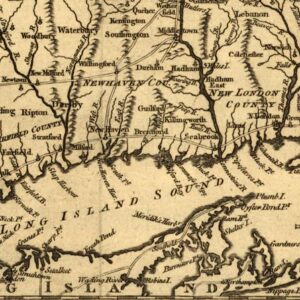
“Legalized Piracy”: Connecticut’s Revolutionary War Privateers
American colonists employed privateers as part of the military effort against the British during the American Revolution.
Read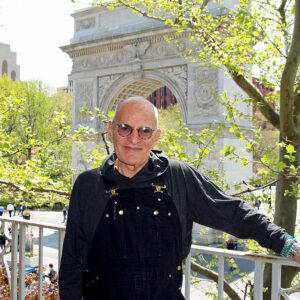
Larry Kramer: Gay Rights and HIV/AIDS Activism
Larry Kramer’s impactful literature and advocacy endeavors altered negative national perceptions to significantly improve AIDS health policies.
Read
Ethel Collins Dunham: Pioneer in Pediatrics
A student and professor of medicine, Dr. Ethel Collins Dunham devoted her life to ensuring the care of children throughout the early and mid-20th century.
Read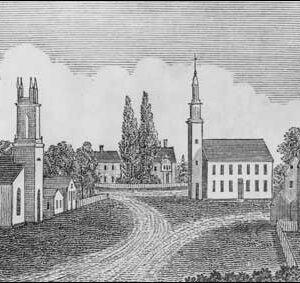
John Warner Barber’s Engravings Chronicle Connecticut History
John Warner Barber chronicled 19th-century Connecticut history through his historical writing and hundreds of engravings—many of which still exist today.
Read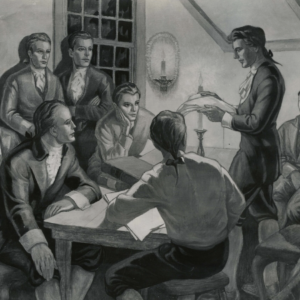
Linonian and Brothers in Unity: The Societies that Built Yale University’s Library
Two undergraduate literary societies, Linonian and Brothers in Unity, donated their large book collections to Yale’s nascent library.
Read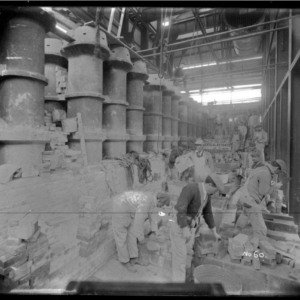
Early Connecticut Gas Light Companies
The first private gas light companies in Connecticut appeared just before 1850 in New Haven, Hartford, and Bridgeport.
Read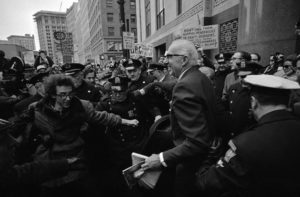
Benjamin Spock: Raising the World’s Children
Pediatrician Benjamin Spock revolutionized childcare in the 20th century before becoming a leading figure in the anti-war movement of the 60s and 70s.
Read
St. Patrick’s Day – Today in History: March 17
On March 17, 1842, the New Haven Hibernian Provident Society, founded in 1841, sponsored the first St. Patrick’s Day Parade held in New Haven.
Read
Sarah Boone: First Connecticut Black Woman to Receive Patent
In1892, Sarah Boone of New Haven became the first Black woman in Connecticut to be awarded a patent—for an improvement in the use of an ironing board.
Read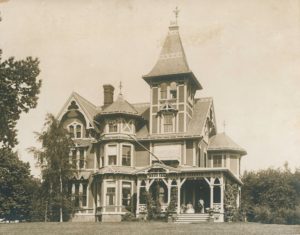
Dr. Mary B. Moody Challenges Victorian Mores About Women in Medicine
New Haven resident Dr. Mary Moody the first female graduate of the medical school at the University of Buffalo, and the first female member of the American Association of Anatomists.
Read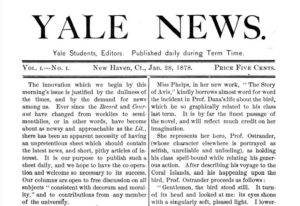
Oldest College Daily – Today in History: January 28
On January 28, 1878, the first edition of the Yale News proclaimed, “The innovation which we begin by this morning’s issue is justified by the dullness of the times, and by the demand for news among us.”
Read
From the State Historian: Discovering the Explorer Hiram Bingham III
Of all the Connecticans who have left their mark in distant places, perhaps none made a more lasting—or more controversial—impression than this explorer.
Read
Timothy Dwight Dies – Today in History: January 11
On January 11, 1817, Timothy Dwight (theologian, educator, poet, and eighth president of Yale) died in New Haven, Connecticut.
Read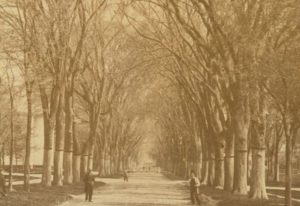
A Beautiful and Goodly Tree: The Rise and Fall of the American Elm
Almost every Connecticut town has an Elm Street, named for the popular trees that grew in abundance until a fungal infestation greatly diminished their numbers.
Read
Early Church Bell Founders
Church bells served many important functions in early New England. Consequently, skilled bellfounders in Connecticut found themselves in high demand.
Read
Benjamin Silliman and the Collection That Inspired the Yale Peabody Museum
Benjamin Silliman published the first American study of a meteor—having acquired access to one that fell near the town of Weston.
Read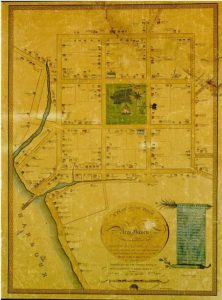
Why Was New Haven Divided into Nine Squares?
The layout of New Haven’s nine-square grid, though not the plan itself, is attributed to the original settlers’ surveyor, John Brockett.
Read
The Kennedys in Connecticut – Today in History: November 6
On November 6, 1960, forty-eight hours before the Presidential election, Senator John F. Kennedy of Massachusetts addressed a street rally in New Haven.
Read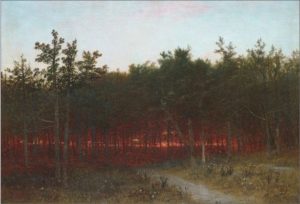
John Frederick Kensett Illuminates the 19th-Century Landscape
John Frederick Kensett was a landscape painter now identified with Luminism—a style of painting utilizing delicate brushstrokes to capture subtle natural light.
Read
Vietnam Protests in Connecticut
Opposition to the war in Vietnam manifested itself in Connecticut in many of the same ways it did across the country.
Read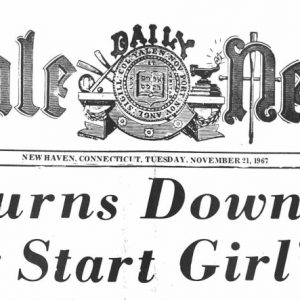
The Merger That Was Not Meant To Be: Yale University and Vassar College
Yale University’s failed merger with Vassar College—a women’s college in Poughkeepsie, New York—in the late-1960s gave Yale the final push into coeducation.
Read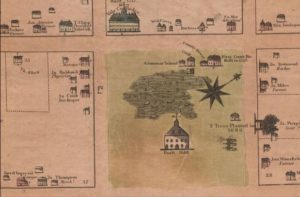
Putting History on the Map
While maps serve a utilitarian function at the time of their production, they become snapshots in time of the memories of those who designed them.
Read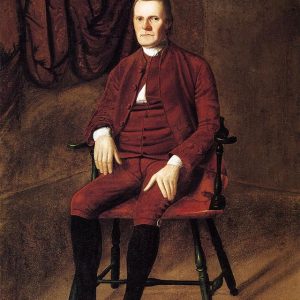
Roger Sherman Dies – Today in History: July 23
On July 23, 1793, Roger Sherman—a Connecticut merchant, lawyer, and statesman—died in New Haven.
Read
The Connecticut Town Green
Considered a quintessential feature of the New England landscape, town greens weren’t always the peaceful, park-like spaces we treasure today.
Read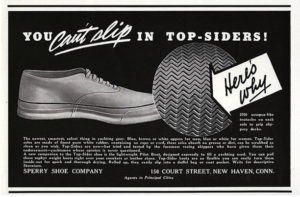
Boat Shoes Have Ties to Connecticut – Who Knew?
During the 1935 winter, Paul Sperry watched his dog run across ice and snow without slipping and got inspired to create a shoe that would help human traction.
Read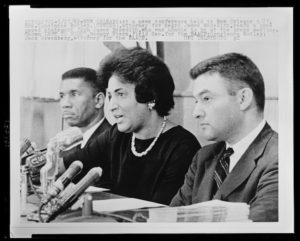
Constance Baker Motley: A Warrior for Justice
New Haven lawyer Constance Baker Motley became famous for arguing some of the most important cases of the civil rights movement.
Read
The Amistad
After enslaved people revolted and took control of the Amistad in 1839, Americans captured the ship off Long Island and imprisoned the enslaved in New Haven.
Read
WDRC AM/FM – Connecticut’s Oldest Commercial Radio Station
WDRC is the oldest continuously operated commercial radio station in Connecticut that uses both AM and FM transmissions.
Read
The Black Panther Party in Connecticut: Community Survival Programs
The Black Panthers had a significant presence in Connecticut in the 1960s and ’70s, particularly through community programs aimed to serve minorities living in the state’s more urban areas.
Read
Louis’ Lunch and the Birth of the Hamburger
In 1900, in answer to a customer’s rush order for something “quick and delicious,” Louis Lassen of New Haven served up a meal that is credited as being the first hamburger.
Read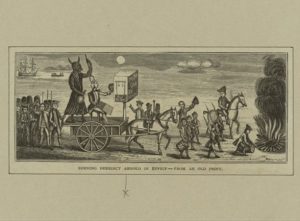
Benedict Arnold: America’s Most Famous Traitor
Benedict Arnold of Norwich was one of the great Continental army heroes of the American Revolution before committing treason and joining the British army.
Read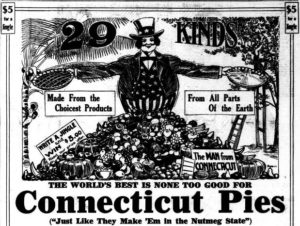
The Pie Man from Georgetown and the Connecticut ~ Copperthite Pie Company
More than just a wagon driver and Civil War veteran, Henry Copperthite built a pie empire that started in Connecticut.
Read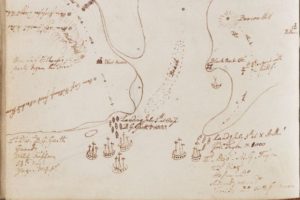
Ezra Stiles Captured 18th-Century Life on Paper
Among Ezra Stiles’ greatest contributions to history are the journals and records he kept detailing daily life in 18th-century New England.
Read
Charles Ritchel and the Dirigible
An entrepreneur’s design for a lighter-than-air vehicle takes flight in the late 1800s and inspires a new state industry.
Read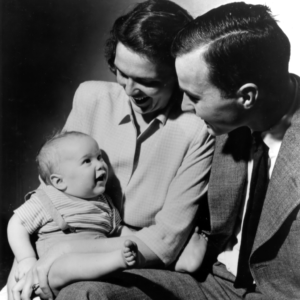
Connecticut’s Only US President – Who Knew?
43rd President George W. Bush was born in New Haven at the Grace-New Haven Community Hospital on July 6, 1946.
Read
A Different Look at the Amistad Trial: The Teenager Who Helped Save the Mende Captives
James Benajmin Covey, a former slave, was only 14 years old when asked to serve in one of the most publicized trials in American history.
Read
Edward Alexander Bouchet: The First African American to Earn a PhD from an American University
Edward Alexander Bouchet was a physicist who was among Yale’s first African American students, and reportedly became the first African American in the United States to earn a PhD.
Read
“Free Bobby, Free Ericka”: The New Haven Black Panther Trials
In 1969, the Black Panther Trials brought national attention to New Haven as prosecutors charged members of the radical movement with murdering one of their own.
Read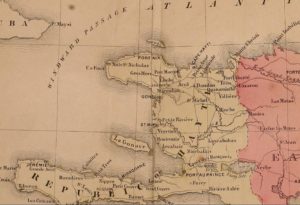
Ebenezer Bassett’s Historic Journey
Ebenezer Bassett, an educator, activist, and associate of Frederick Douglass, served the US as its first African American ambassador.
Read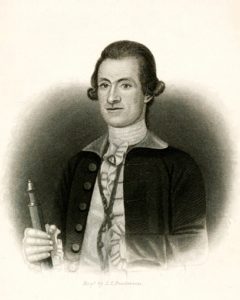
William Douglas: A Colonial Hero’s Sacrifice
William Douglas was a successful merchant and military leader who settled in North Branford just prior to the Revolutionary War.
Read
Farmington Canal Designed to Give Connecticut Commerce a Competitive Edge
The Farmington Canal serves as an example of how developments in transportation played a pivotal role in facilitating the country’s industrial activity.
Read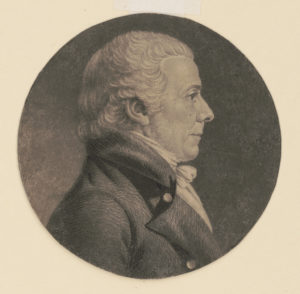
The Revolution of 1817
The Connecticut gubernatorial election of 1817 transferred power from the Federalists to the Republican Party, ending the Congregational Church’s domination.
Read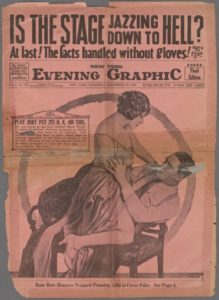
Emile Gauvreau and the Era of Tabloid Journalism
Emile Gauvreau, former managing editor of the Hartford Courant, became a pioneer in the rise of tabloid journalism.
Read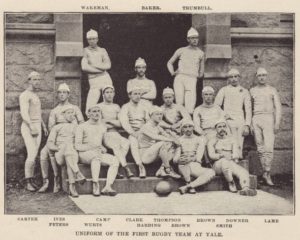
Foot Ball Match: Harvard vs. Yale – Today in History: November 13
On November 13, 1875, Yale and Harvard wore the first team uniforms in an American intercollegiate football game.
Read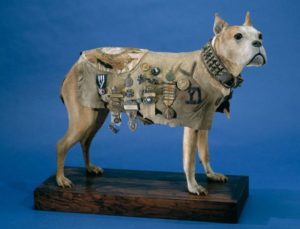
A True Dog of War: Sergeant Stubby
The stray dog “Stubby” quickly became the mascot of the 102nd Infantry during WWI, despite an official ban on pets in the camp.
Read
Alfred Howe Terry Born in Hartford – Today in History: November 10
Alfred Howe Terry’s greatest achievement in the Civil War was his capture of Fort Fisher in January, 1865.
Read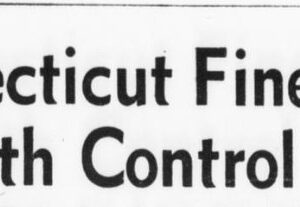
Taking on the State: Griswold v. Connecticut
In the 1960s, Estelle Griswold challenged Connecticut’s restrictive birth control law, making it all the way to the Supreme Court.
Read
The “Red Scare” in Connecticut
The Palmer Raids, launched in Connecticut in 1919, were part of the “Red Scare” paranoia that resulted in numerous civil rights violations committed by law enforcement officials.
Read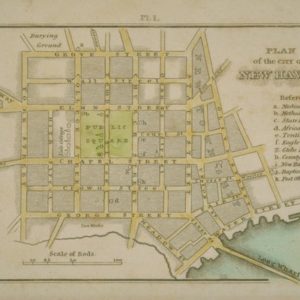
New Haven’s Long Wharf
From the 17th through the 19th centuries, the economic prosperity of New Haven significantly depended upon Long Wharf.
Read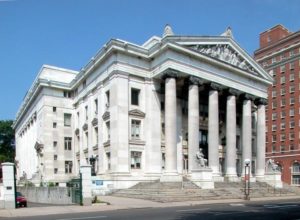
Planned Parenthood League of Connecticut – Today in History: November 1
On November 1, 1961, Estelle Griswold and Dr. C. Lee Buxton opened the Planned Parenthood League of Connecticut in New Haven.
Read
Yale University Art Gallery – Today in History: October 25
Also known as the Picture Gallery, the Trumbull Gallery holds the distinction of being the first art museum at an educational institution in the United States.
Read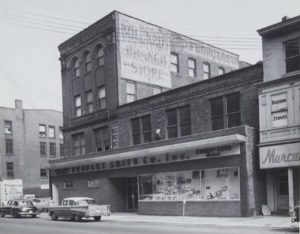
New Haven Gives the Lollipop its Name – Today in History: October 13
On October 13, 1931, the name “Lolly Pop” was officially registered to the Bradley Smith Company of New Haven by the US Patent and Trademark Office.
Read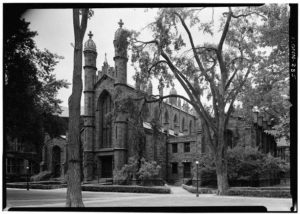
Timothy Dwight Provides Religious, Military, and Educational Services for a Young Country
Timothy Dwight was an influential preacher, poet, and educator who served as a chaplain during the Revolutionary War and later as the president of Yale College.
Read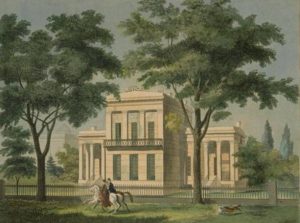
American Architect Ithiel Town Born – Today in History: October 3
On October 3, 1784, prominent American architect and engineer Ithiel Town was born in Thompson.
Read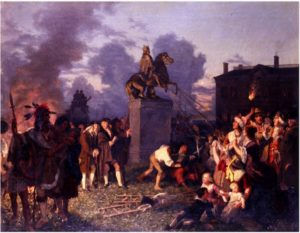
Mariann Wolcott and Ralph Earl – Opposites Come Together and Make History
The story of Mariann Wolcott and Ralph Earl captures much of the complexity the Revolutionary War brought to the lives and interactions of ordinary citizens.
Read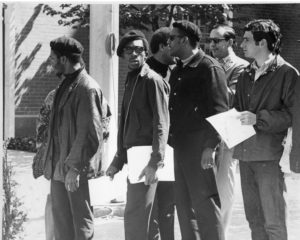
The Rise of the Black Panther Party in Connecticut
The Black Panther Party in Connecticut fought for an end to discriminatory legal and regulatory practices, often clashing with authorities to achieve their goals.
Read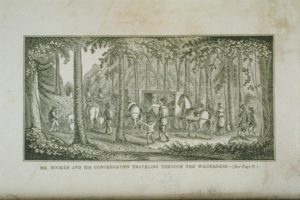
The Importance of Being Puritan: Church and State in Colonial Connecticut
Connecticut Protestants wanted to cleanse the church of what they saw as corruption, and to return to the simplicity and purity of early Christian worship.
Read
The Rev. Amos Beman’s Devotion to Education, Social Activism, and New Haven
Amos Beman spent much of his life a religious leader and social activist in New Haven, fighting the stereotypes and other obstacles he encountered because of his race.
Read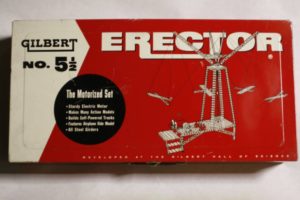
Erector Set Patented – Today in History: July 8
On July 8, 1913, the United States Patent Office issued a patent to Alfred C. Gilbert of New Haven for his “Toy Construction-Blocks.”
Read
The Blake Rock Crusher – Today in History: June 15
On June 15, 1858, Eli Whitney’s nephew, Eli Whitney Blake of New Haven was granted US patent No. 20,542 for a “machine for crushing stone.”
Read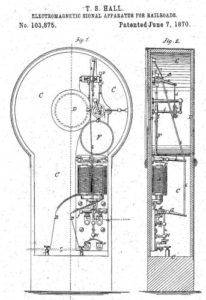
Thomas Hall’s Electric Block Railroad Signal – Today in History: June 7
On June 7, 1870, Thomas Hall patented the electromagnetic signal apparatus for railroads–better known as the automatic electric block.
Read
Noah Webster and the Dream of a Common Language
Best remembered for the dictionary that now bears his name, Noah Webster played a pivotal role in shaping the young nation’s political and social identity.
Read
Modernism in Connecticut through Photographs
A creed as much as a style, Modernism rejected the forms of the past in favor of an architecture that reflected a new spirit of living.
Read
The Yale-Storrs Controversy
In the late 1800s, under pressure from frustrated farmers, the Connecticut General Assembly voted to transfer land-grant status and revenue from Yale to the Storrs Agricultural School (UConn).
Read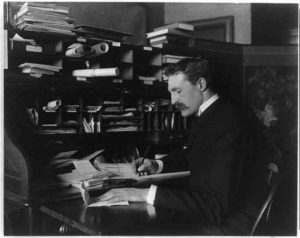
Gifford Pinchot: Bridging Two Eras of National Conservation
Connecticut-born Gifford Pinochet oversaw the rapid expansion of national forest land holdings in the early 1900s.
Read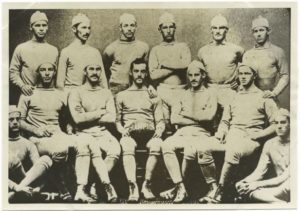
The “Father of American Football” is Born – Today in History: April 7
A native of New Britain, Walter Camp helped revolutionize the game of American football while a student and coach at Yale and for several years afterward.
Read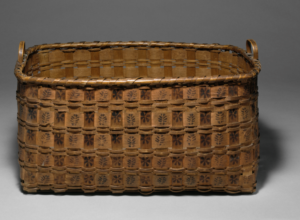
Quinnipiac: The People of the Long Water Land
The Quinnipiac still live in Connecticut and across the country, but the community is not presently one of Connecticut’s recognized tribes, nor is it federally acknowledged.
Read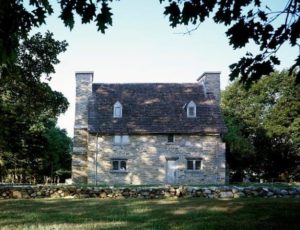
J. Frederick Kelly: Constructing Connecticut’s Architectural History
J. Frederick Kelly was both a well-known architect, preservationist, and architectural historian, whose works chronicled many of Connecticut’s historical properties.
Read
Paleontologist Othniel Marsh dies – Today in History: March 18
On March 18, 1899, America’s first professor of paleontology, Othniel Charles Marsh, died at his home in New Haven.
Read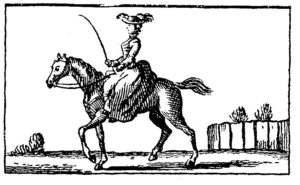
Sarah Kemble Knight’s Journey through Colonial Connecticut
In 1704, when long distance travel was rare and roads crude, a Boston woman journeyed by horseback to New York City and recorded her views of Connecticut along the way.
Read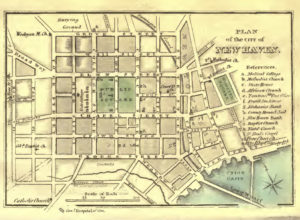
The Successes and Struggles of New Haven Entrepreneur William Lanson
The life of this savvy businessman illustrates the possibilities—and limits—urban Connecticut presented to African Americans in the early 1800s.
Read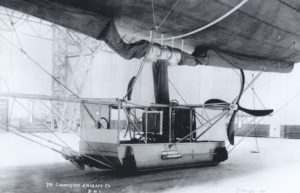
DN-1: The US Navy’s First Airship
The United States military’s experience with lighter-than-air technology began with the Connecticut Aircraft Company’s DN-1 airship built for the navy in 1917.
Read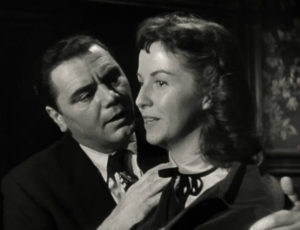
Ernest Borgnine: Breaking the Hollywood Mold
Ernest Borgnine, a native of Hamden who served ten years in navy, became one of the world’s most recognized and revered actors.
Read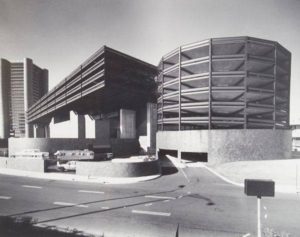
New Haven Coliseum Imploded – Today in History: January 20
On January 20, 2007, the 35-year-old New Haven Veterans Memorial Coliseum met its end as crews imploded the partially dismantled structure.
Read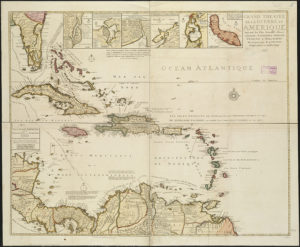
Connecticut and the West Indies: Sugar Spurs Trans-Atlantic Trade
This profitable exchange brought wealth and sought-after goods to the state but came at the price of supporting slavery in the bargain.
Read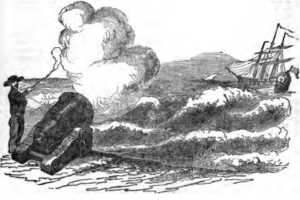
The Ghost Ship of New Haven Sets Sail Shrouded in Mystery
Tales of a spectral ship seen sailing in the skies above New Haven have haunted Connecticut’s imagination since the late 1640s.
Read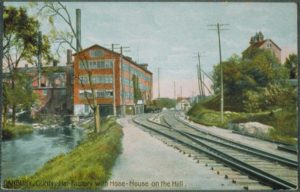
Rivers of Outrage
Pollution of Connecticut’s waters by industrial waste and sewage in the decades after the Civil War was arguably the state’s first modern environmental crisis.
Read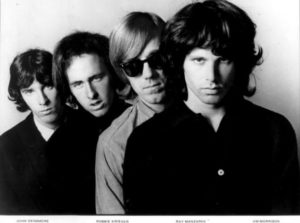
Jim Morrison Arrested – Today in History: December 9
On December 9, 1967, police arrested Doors’ front man Jim Morrison as he performed onstage at the New Haven Arena.
Read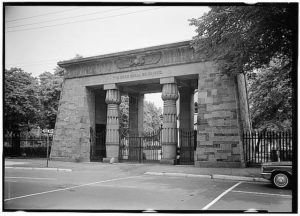
Father of Architects Born – Today in History: December 4
On December 4, 1804, “Father of Architects” Henry Austin was born in the Mt. Carmel section of Hamden, Connecticut.
Read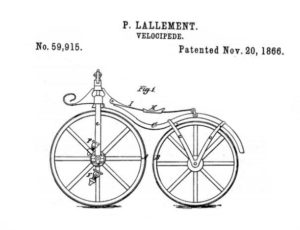
Pierre Lallement and the Modern-Day Pedal Bicycle – Today in History: November 20
On November 20, 1866, mechanic Pierre Lallement, a temporary resident of New Haven, Connecticut, received a patent for an improvement in velocipedes.
Read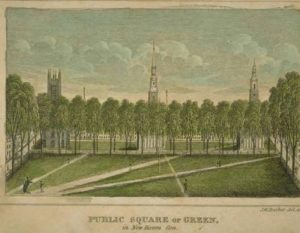
A Separate Place: The New Haven Colony, 1638-1665
In 1638, Puritan leader John Davenport led a group of settlers out of Boston, ultimately founding what became the New Haven Colony.
Read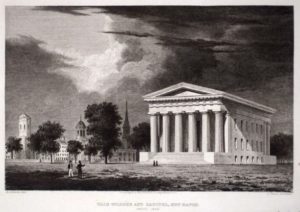
Hartford and New Haven: A Tale of Two Capitals
Before the expense of having two capital cities became too great, both Hartford and New Haven served that function. Hartford became the sole capital in 1875.
Read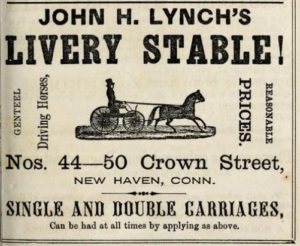
New Haven: What Was Everyday Life Like During the Civil War?
A great primary resource for digging into a community’s everyday life is a city directory.
Read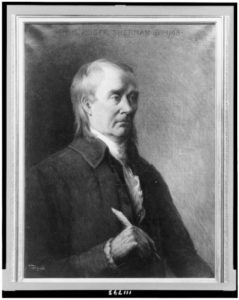
Roger Sherman, Revolutionary and Dedicated Public Servant
Roger Sherman is also the only person to have signed all four of the most significant documents in our nation’s early history.
Read
When Old Saybrook Was a College Town
Yale University traces its origins back to the Connecticut Colony’s passing of “An Act for the Liberty to Erect a Collegiate School” in 1701.
Read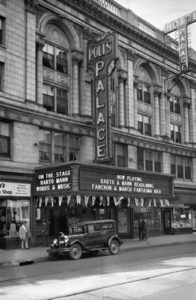
Sylvester Poli, Negotiating Cultural Politics in an Age of Immigration
This Italian-born businessman and New England theater magnate also helped the working poor in New Haven’s immigrant communities at the turn of the 20th century.
Read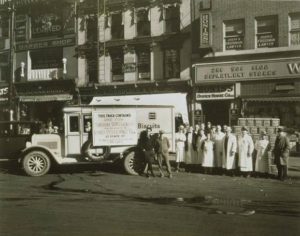
Oystering in Connecticut, from Colonial Times to the 21st Century
Why tasty Crassostrea virginica deserves its honored title as state shellfish.
Read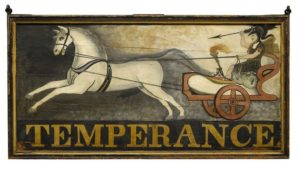
Hope for the West: The Life and Mission of Lyman Beecher
Lyman Beecher was one of the most influential Protestant preachers of the 19th century, as well as father to some of the nation’s greatest preachers, writers, and social activists.
Read
The Hartford Wits
Eventually taking the name the “Hartford Wits,” influential figures of the 18th century got together to write poetry that documented the state of the times.
Read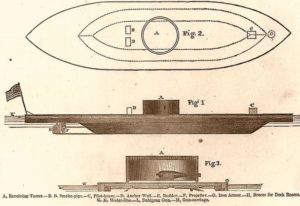
Cornelius Bushnell and His Ironclad Ship
Cornelius Scranton Bushnell was a 19th-century Connecticut businessman and shipbuilder whose successfully lobbied on behalf of a local railroad enterprise.
Read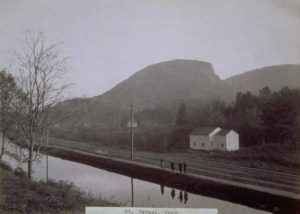
New England’s Grand Ambition: The Farmington Canal
Connecticut took leading role in waterway that transformed the region’s commerce.
Read
The Origins and Enduring Legacy of New Haven’s Long Wharf Theatre
As a smaller, quieter alternative to Broadway, New Haven’s Long Wharf Theatre overcame an unconventional location to become a smash success.
Read
Furniture Caster Patented – Today in History: June 30
On June 30, 1838, the US patent No. 821—the first for a furniture caster—was granted to the Blake Brothers of New Haven.
Read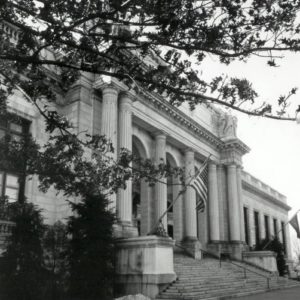
Parking Authority Created in New Haven – Today in History: June 2
On June 2, 1953, the Connecticut Supreme Court of Errors ruled that creating a parking authority in the city of New Haven was constitutional.
Read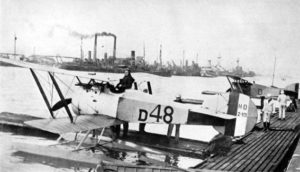
The First Yale Unit: How U.S. Navy Aviation Began
The legacy forged by the First Yale Unit lead to the creation of the Army Air Corps and military aviation as we know it.
Read
News From Lexington: Contemporary Views of the Opening Battles of the American Revolution
A rare set of prints by New Haven printer Amos Doolittle depicts the momentous events of April 19, 1775.
Read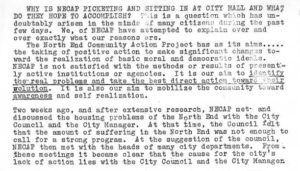
The Northern Student Movement
The Northern Student Movement motivated college students to contribute their energies to important social causes such as literacy and civil rights.
Read
Forgotten Founder: John Davenport of New Haven
John Davenport, the founder of New Haven, was a prominent Puritan leader during the early years of the New England colonies.
Read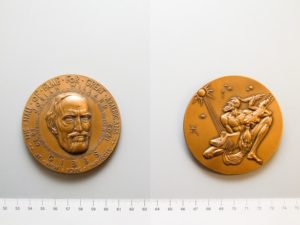
Josiah Willard Gibbs’s Impact on Modern Science
New Haven’s Josiah Willard Gibbs laid the groundwork for the development of physical chemistry as a science.
Read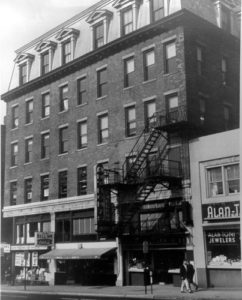
First Commercial Telephone Exchange – Today in History: January 28
On January 28, 1878, the Boardman Building became the site of the world’s first commercial telephone exchange, the District Telephone Company of New Haven.
Read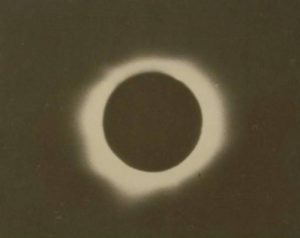
The Astronomical Event of the Century
Church bells chimed and factory whistles blew and automobiles, trains, and trolleys throughout the state came to a standstill.
Read
An Uncommonly Ingenious Mechanic: Abel Buell of Connecticut
This Yankee jack-of-all-trades, Abel Buell, created the first map of the new United States to be printed and published in America.
Read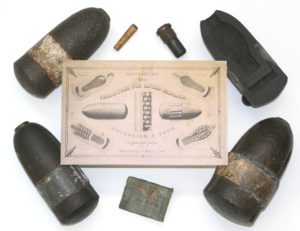
Connecticut Arms the Union
By the Civil War’s end, Connecticut had supplied 43% of the total of all rifle muskets, breech loading rifles and carbines, and revolvers bought by the War Department.
Read
Honor and Duty: The Life of Alfred Howe Terry
Born in Hartford, Alfred Howe Terry studied law before heroically capturing Fort Fisher during the Civil War.
Read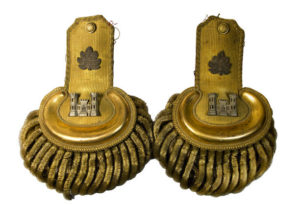
One of the Honored Dead: General J. K. F. Mansfield
A resident of New Haven and Middletown, Joseph Mansfield rose to the rank of brigadier general in the Union army before losing his life at the Battle of Antietam.
Read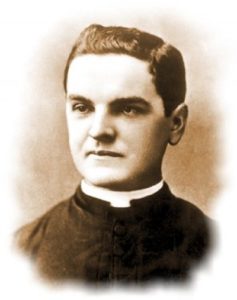
Knights of Columbus Chartered – Today in History: March 29
In October 1881, the Reverend Michael Joseph McGivney and male parishioners of St. Mary’s Roman Catholic church in New Haven founded Knights of Columbus.
Read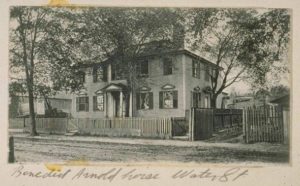
Benedict Arnold died in London, England – Today in History: June 14
On June 14, 1801, Revolutionary War general and traitor Benedict Arnold died in London.
Read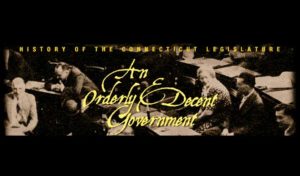
An Orderly & Decent Government: Making Self-Government Work, 1634-1776
In 1698 the General Court reorganized itself to deal more effectively with Connecticut’s complex new problems.
Read
An Orderly & Decent Government: Making Self-Government Work, 1819-1865
In the mid-19th century, Connecticut looked toward changing its electoral processes as well as its civil rights record.
Read
An Orderly & Decent Government: Making Self-Government Work, 1866-1887
The late 1800s witnessed significant challenges to Connecticut’s voting and taxation laws.
Read
Alfred Carlton Gilbert, Inventor of the Erector Set – Today in History: February 15
A. C. Gilbert, a successful Olympic athlete, invented the Erector Set after being inspired by the structures he saw while on a train ride from New Haven to New York in 1911.
Read
Yale University from Colonial Times to the Present
Yale University has grown from the small “Collegiate School” founded in Saybrook in 1701 to one of the most prestigious universities in the world.
Read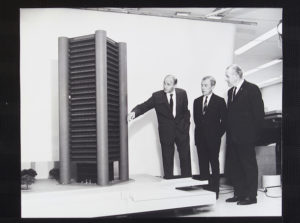
Richard Lee’s Urban Renewal in New Haven
Thanks largely to his efforts at Urban Renewal, New Haven’s Richard C. Lee became one of the most celebrated and well-known mayors of the 20th century.
Read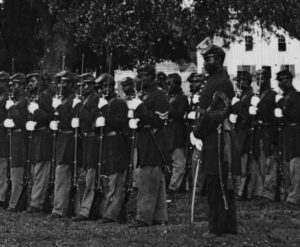
29th Connecticut Colored Infantry Regiment
The state’s first African American regiment of the Civil War distinguished itself by battling Confederate forces and 19th-century prejudices.
Read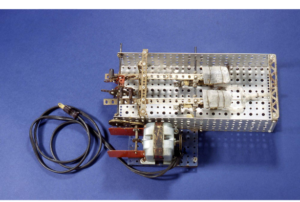
Heart Pump out of an Erector Set – Who Knew?
Yale medical student William Sewell Jr. built the first artificial heart (partly out of Erector Set pieces), and conducted successful bypass experiments in 1949.
Read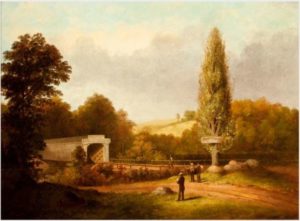
Echoes of the Old World: The Architectural Legacy of Ithiel Town
Ithiel Town was one of the first professional architects in Connecticut and one of the first to introduce the architectural styles of Europe to the United States.
Read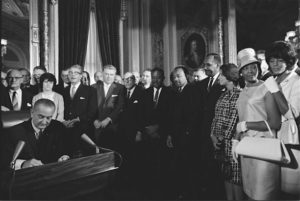
Selma, Not So Far Away
Father Leonard Tartaglia was sometimes called Hartford’s “Hoodlum Priest.” Like the 1961 film of the same name, Tartaglia ministered to the city’s poor and disenfranchised.
Read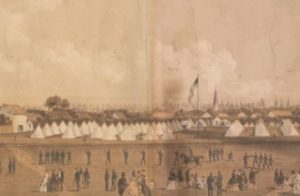
What’s in a Number? Connecticut’s Thirteenth Regiment Goes Off to War
So how lucky was the Thirteenth when it came to surviving combat, disease, and other perils of the Civil War? Read on to find out.
Read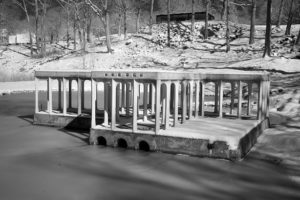
Philip Johnson in His Own Words
In 1985, this famed architect offered a candid take on his life and work, with the stipulation that it not be made public until after his death.
Read
Benedict Arnold Demands the Key – Today in History: April 22
On April 22, 1775, Benedict Arnold demanded the key to New Haven’s powder house.
Read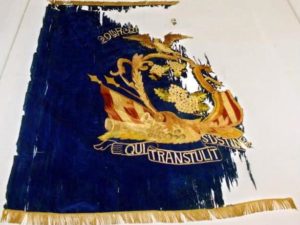
The 29th Connecticut Colored Infantry Regiment Leaves for War – Today in History: March 19
On March 19, 1864, the 29th Connecticut Colored Infantry Regiment was preparing for deployment to the South to fight in the Civil War.
Read
When the World Ran on Connecticut Time
The success of the clock- and watch-making industries in Connecticut came about in an era when the state was just beginning to realize its industrial potential.
Read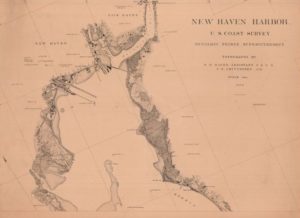
Three Young Engineers: Charting New Haven
When the United States Coast Survey set out to compile detailed charts of New Haven Harbor in the 1870s, they hired recent graduates of Yale’s Sheffield Scientific School as assistants.
Read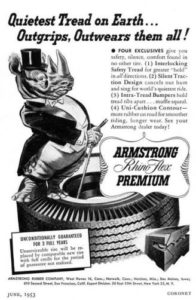
Armstrong Finds a Niche in the Tire Market
Armstrong tires, one of the most popular brands of automobile and farm equipment tires in the 20th century, has its roots in West Haven, Connecticut.
Read
Medical Pioneer Eli Todd born – Today in History: July 22
On July 22, 1769, Eli Todd was born in New Haven and in 1824 became the first director of the Connecticut Retreat for the Insane in Hartford.
ReadMore Articles




